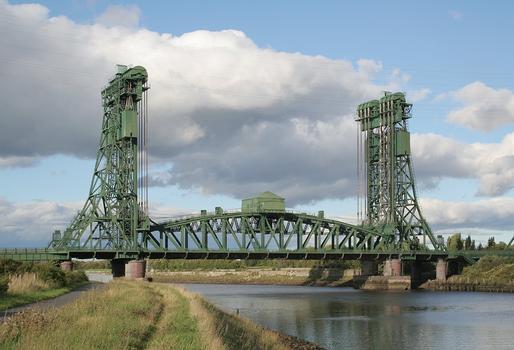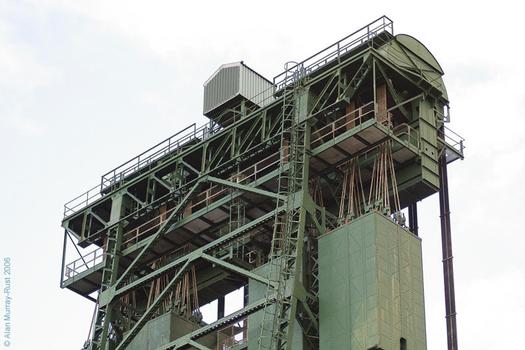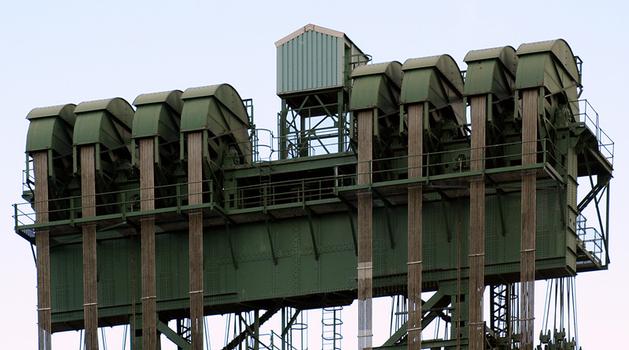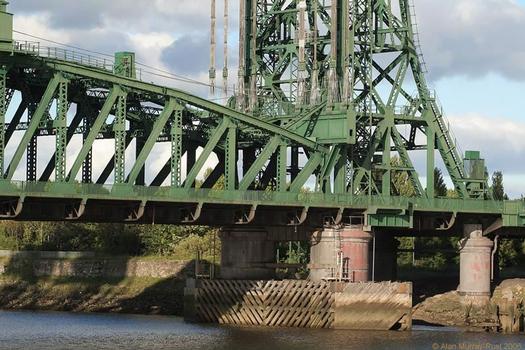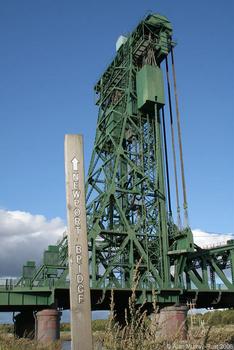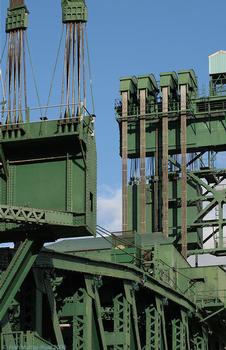General Information
Project Type
| Structure: |
Vertical lift bridge |
|---|---|
| Function / usage: |
Road bridge |
| Material: |
Steel bridge |
Location
| Location: |
Middlesbrough, Middlesbrough, North Yorkshire, North East England, England, United Kingdom |
|---|---|
| Crosses: |
|
| Coordinates: | 54° 34' 18.43" N 1° 15' 40.92" W |
Technical Information
Dimensions
| main span | 82 m | |
| tower height | 55 m | |
| length | ca. 122 m |
Cost
| cost of construction | Pound sterling 512 353 |
Materials
| towers |
steel
|
|---|---|
| truss |
steel
|
Chronology
| 28 February 1934 | Opened by the Duke of York (later King George VI). |
|---|---|
| 18 November 1990 | The vertical lift mechanism is used for the last time. |
Excerpt from Wikipedia
The Tees Newport Bridge is a vertical-lift bridge spanning the River Tees a short distance upriver from Tees Transporter Bridge, linking Middlesbrough with the borough of Stockton-on-Tees, in the northeast of England; it was completed in 1934. It no longer lifts, but still acts as a road bridge in its permanently down position.
History
Designed by Mott, Hay and Anderson and built by local company Dorman Long, who have also been responsible for such structures as the Tyne Bridge and Sydney Harbour Bridge, it was the first large vertical-lift bridge in Britain.
The bridge was inaugurated by Prince Albert, Duke of York (later King George VI) and opened to traffic on 28 February 1934. Constructed around twin 55 m (180 ft) lifting towers, the 82 m (269 ft) bridge span, weighing 2,700 tonnes, could be lifted by the use of two 325 H.P. electric motors at 16 m (52 ft) per minute to a maximum height of 37 m (121 ft). In the event of motor failure a standby 450 H.P. petrol engine could be employed to move the bridge, but should both systems fail it was possible to raise or lower the span manually using a winch mechanism. It was estimated in 1963 by Mr R. Batty, long time Bridge Master at Newport Bridge, that "it would take 12 men eight hours" to complete the movement by hand.
Originally, 12 men would have been employed to man the bridge around the clock, usually requiring four to drive it at any one time. This was accomplished from the oak-panelled winding house situated midway along the bridge span. During the 1940s and early 1950s this would occur up to twice a day with an average of 800 vessels per year passing under it, despite staffing difficulties during the 1940s when men were away fighting. However, as the number of ships needing to sail up to Stockton-on-Tees declined, so did the usage of the bridge.
The legal requirement to lift the bridge for shipping traffic was removed in 1989 after the repeal of a Parliamentary Act. Before mechanical decommissioning Mr Ian MacDonald, who worked on the bridge from 1966, finally as Bridge Master, supervised the final lift on 18 November 1990.
The Tees Newport Bridge still serves as a road bridge, carrying considerable traffic as a section of the A1032, despite the presence of the A19 Tees Viaduct a short distance upriver. In recent years it was repainted in its original green and some minor maintenance took place on the wire ropes and counterbalances which still take the majority of the bridge load. In 1988 the bridge was given Grade II Listed Building status.
Work started in July 2014 to paint the bridge red and silver to mark its 80th anniversary. The work was originally planned to take 6 weeks, but was completed behind schedule and over-budget in October 2015. The main cause for the delay was that the bridge had not been maintained by Stockton Council for 15 years, and much of the steelwork was in a poor condition.
Text imported from Wikipedia article "Tees Newport Bridge" and modified on 23 July 2019 under the CC-BY-SA 3.0 license.
Participants
Relevant Web Sites
Relevant Publications
- Le pont levant sur la Tees à Middlesbrough, Angleterre. In: Ossature métallique, v. 3 (May 1934), pp. 251-255.
- (1935): Tees (Newport) Bridge, Middlesbrough. In: Minutes of the Proceedings of the Institution of Civil Engineers, v. 240, n. 1935-2 ( 1935), pp. 567-598, plate.
- About this
data sheet - Structure-ID
20006349 - Published on:
18/10/2002 - Last updated on:
23/05/2016

